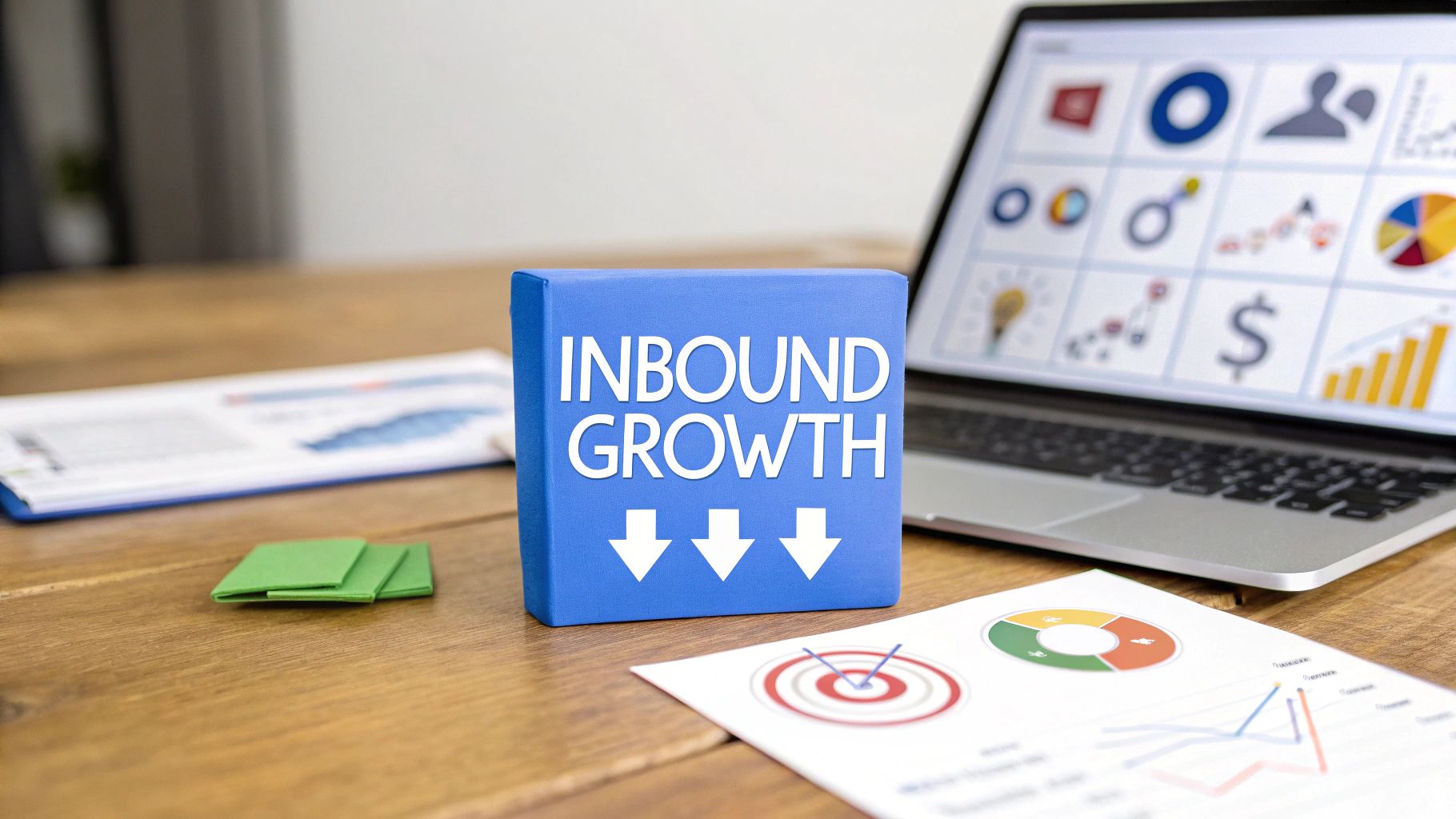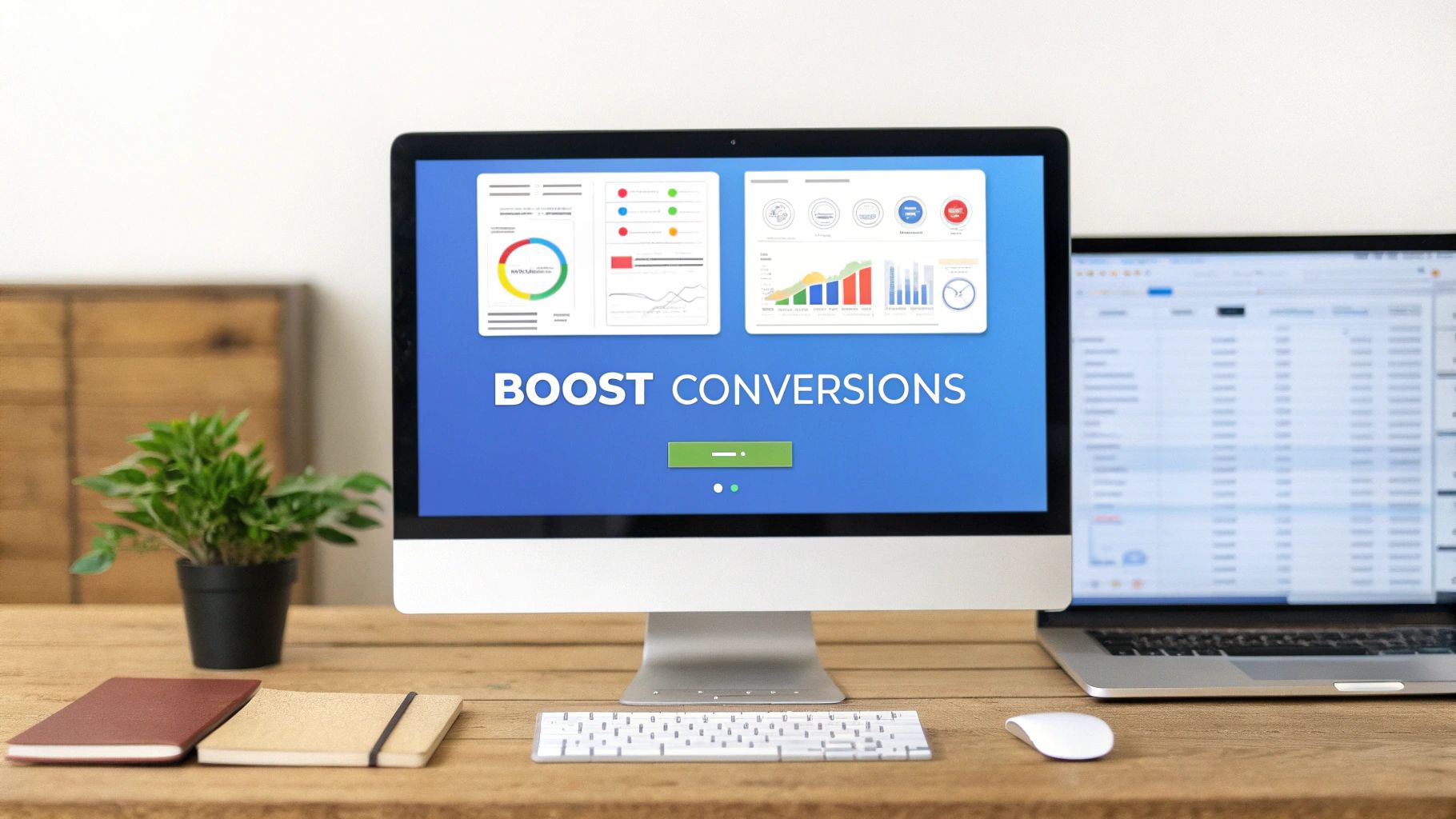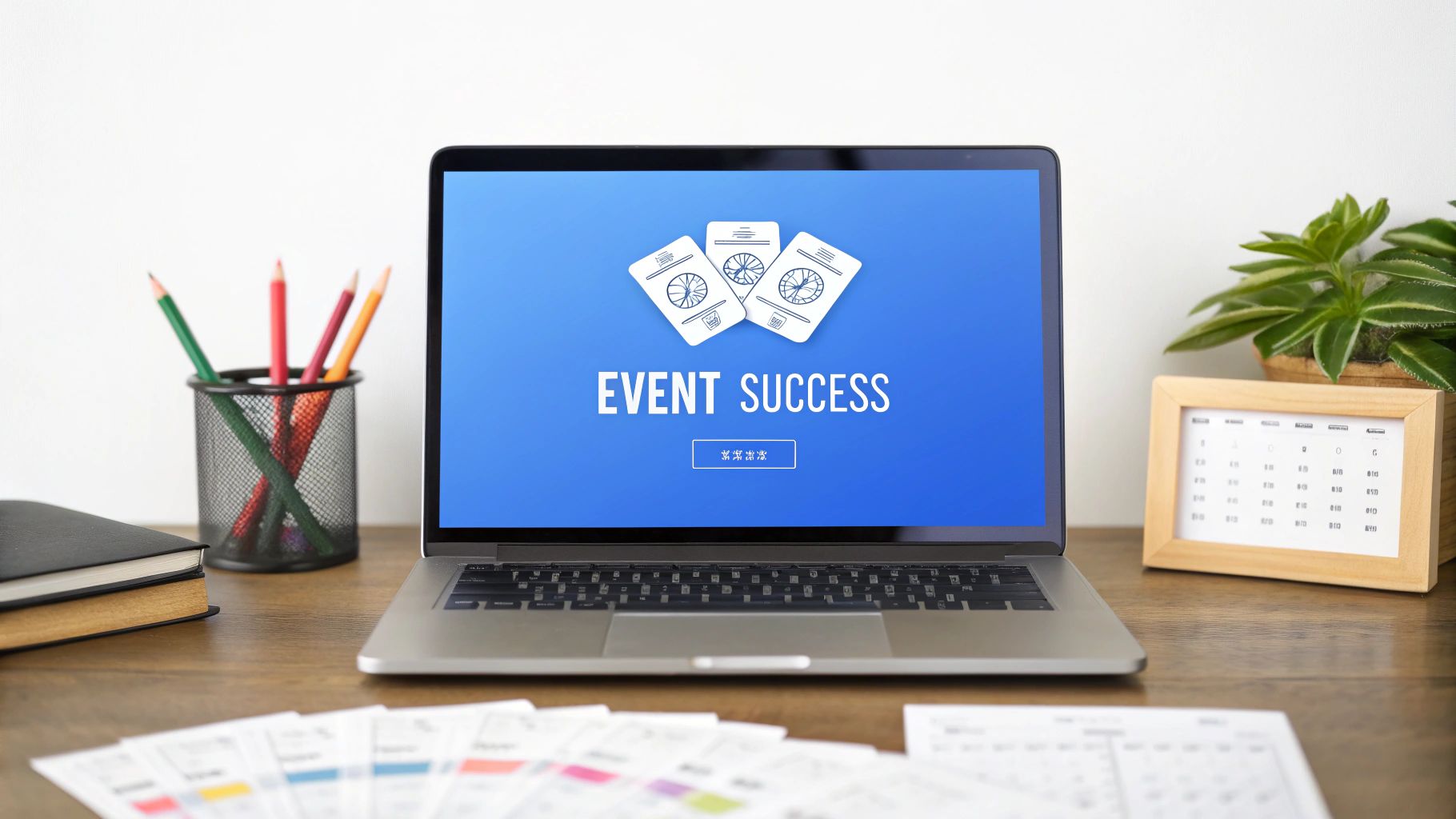Summary
Meta Description: Master inbound marketing lead generation with our complete guide. Learn how to attract, convert, and nurture high-quality leads for real business growth.
Inbound marketing lead generation is the art of attracting potential customers with content they genuinely want, rather than interrupting them with ads they don't. It’s about building a system that pulls interested people to your business naturally. This strategy turns strangers into happy customers by being genuinely helpful.
Why Inbound Marketing Is a Magnet for Leads
Are you tired of chasing customers who seem to vanish into thin air? Traditional outbound marketing often feels like shouting into the wind. Cold calls, disruptive ads, and direct mail usually end up ignored or in the trash. It’s expensive, it's annoying, and let's be honest—most of us have become experts at tuning it out.
Inbound marketing flips that entire script.
Think of your business as a powerful magnet. Instead of pushing your message out, you create a strong magnetic field that pulls the right people in. What creates this field? Valuable content. We're talking about blog posts that solve real problems, guides that answer burning questions, and social media updates that actually engage and inform.
The Power of Attraction Over Interruption
At its core, inbound marketing is about earning attention, not buying it. When a potential customer is actively searching for a solution, your content is right there waiting. They find you, not the other way around. This simple shift builds a relationship based on trust and value from the very first click.
Because these prospects are the ones initiating contact, they're already more qualified and interested in what you have to say. This isn’t just a nice idea; the numbers prove it works. Inbound marketing strategies generate 54% more leads than old-school outbound methods. Even better, inbound marketing costs 62% less per lead, making it a much more sustainable way to grow your business.
How to Focus on the Right Audience
The secret to making this work? Knowing exactly who you're trying to attract. When you deeply understand your ideal customer's challenges and goals, you can create content that speaks directly to them. This ensures you're not just getting traffic, but the right traffic. To nail this, you need to get good at what is audience segmentation.
Ultimately, inbound marketing isn't about quick wins or pushy sales tactics. It's a long-term strategy for building a loyal following, establishing your brand as a trusted expert, and creating a reliable pipeline of high-quality leads who are actually excited to hear from you.
Ready to stop chasing and start attracting?
Laying Your Inbound Marketing Foundation
A killer inbound marketing strategy doesn't just happen. It doesn’t start with a clever blog post or a viral social media campaign. It starts with a blueprint.
Think of it like building a house. You wouldn't just start hammering boards together without a solid foundation, right? The same goes for attracting high-quality leads. Your success depends on two core pillars: knowing exactly who you're talking to and what you need to say.
Before a single word is written, you have to get inside the head of your ideal customer. And I mean really get inside their head, far beyond basic demographics. This is where buyer personas come in—detailed profiles of your perfect customers, built from real data and solid market research.
What are their biggest headaches at work? What keeps them up at night? What are the embarrassing questions they're secretly typing into Google?
Answering these questions is the difference between shouting into a void and having a real conversation. You stop guessing and start creating content that speaks directly to their pains and solves their problems.
Building Your Buyer Personas
A truly useful buyer persona isn't just a list of facts; it’s about uncovering the human being behind the screen. You need to understand their world so you can earn a place in it.
Start by digging into the essentials:
- Role and Responsibilities: What's their job title? What are they actually responsible for, and how is their performance measured?
- Goals: What are they trying to accomplish? Are they gunning for a promotion, trying to improve team performance, or just trying to make their own life easier?
- Challenges: What's standing in their way? Maybe it's a tight budget, clunky software, or getting their boss to say "yes" to a new idea.
- Information Sources: Where do they hang out online for information? Are they reading industry blogs, attending webinars, or trusting peer recommendations?
A well-crafted buyer persona is your marketing North Star. Every decision you make—from the topics you write about to the tone you use—should be filtered through one simple question: "Would this resonate with them?"
This infographic does a great job of showing the fundamental difference between inbound's magnetic pull and the old-school megaphone approach of outbound.
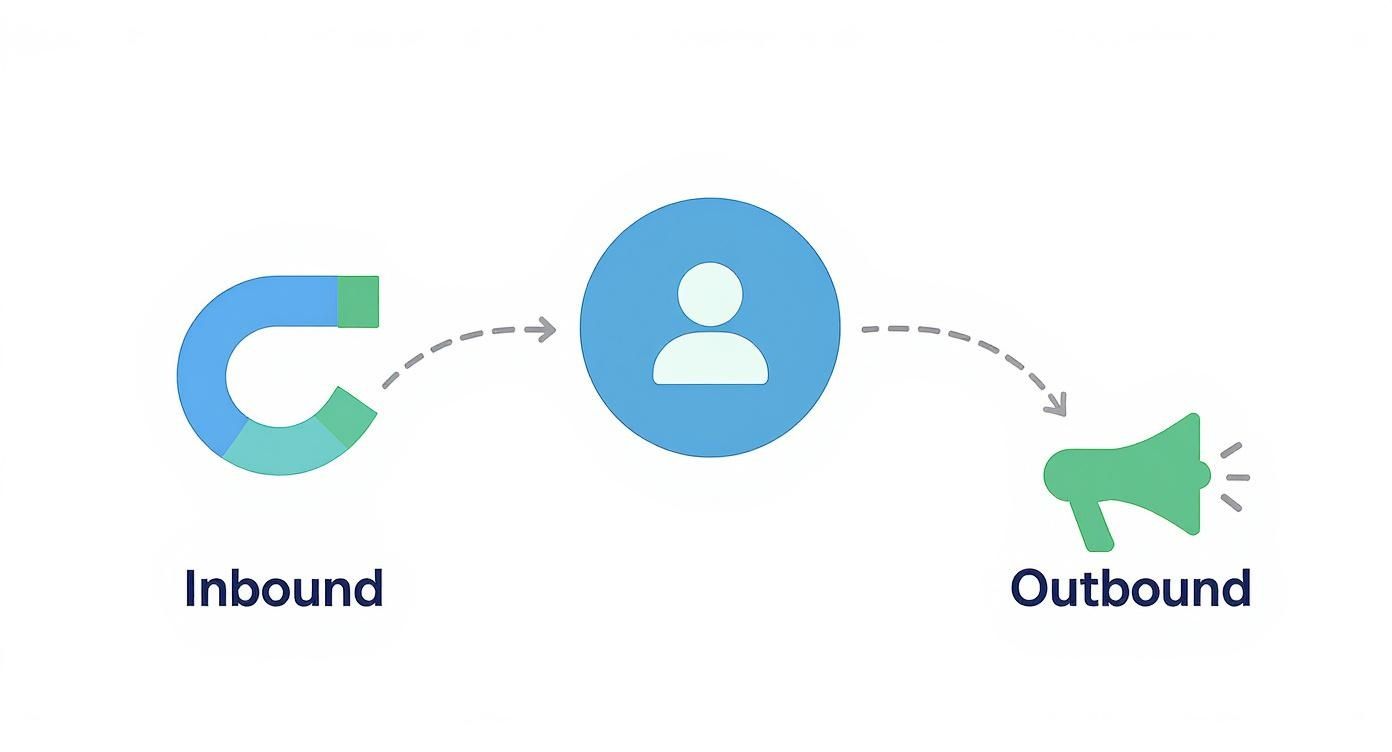
As you can see, inbound is all about attracting customers with value. Outbound is about pushing a message at them. Big difference.
How to Map Content to the Buyer's Journey
Once you know who you're talking to, the next piece of the puzzle is figuring out what to say and when to say it. This is where the buyer's journey is your best friend. It’s a simple framework that maps out the research process people go through before they decide to buy something.
It breaks down into three classic stages.
- Awareness Stage: The person knows they have a problem, but they might not have a name for it yet. They're doing broad, educational research to understand their symptoms. Your content here needs to be helpful and diagnostic, not salesy. Think blog posts ("5 Signs You're Wasting Money on..."), ebooks, and research reports.
- Consideration Stage: Now they’ve put a name to their problem. They're actively researching all the different ways they could solve it. This is where they compare different types of solutions. Expert guides, webinars, and comparison sheets are pure gold here.
- Decision Stage: They've picked a solution strategy, and now they're trying to choose the right vendor or product. They need proof that you're the best choice. This is the time for case studies, free trials, and product demos to seal the deal.
By mapping your content to each stage, you deliver the right message at the exact moment they need it. You become a trusted guide, not just another pushy salesperson.
This journey-based approach turns a simple content calendar into a legitimate lead generation machine. Of course, once you have these leads, you'll need a smart way to guide them, which is where you can start exploring different marketing automation workflows to keep the conversation going.
Creating Content That People Want to Trade For
At its core, inbound marketing is built on a simple exchange: you offer truly valuable information, and in return, your ideal customer gives you their attention and contact details. This is the heart of inbound marketing lead generation. Your content isn't just filler—it's the currency you use to earn trust and kick off a relationship.
Think about it. Would you hand over your email address to a stranger for no good reason? Of course not. But what if they were offering a detailed guide that solves the exact headache you’ve been dealing with all week? Suddenly, it feels less like giving something away and more like a fair trade.
That’s the mindset you need to adopt. You're not just publishing articles; you're creating assets valuable enough to earn a spot in someone's inbox.
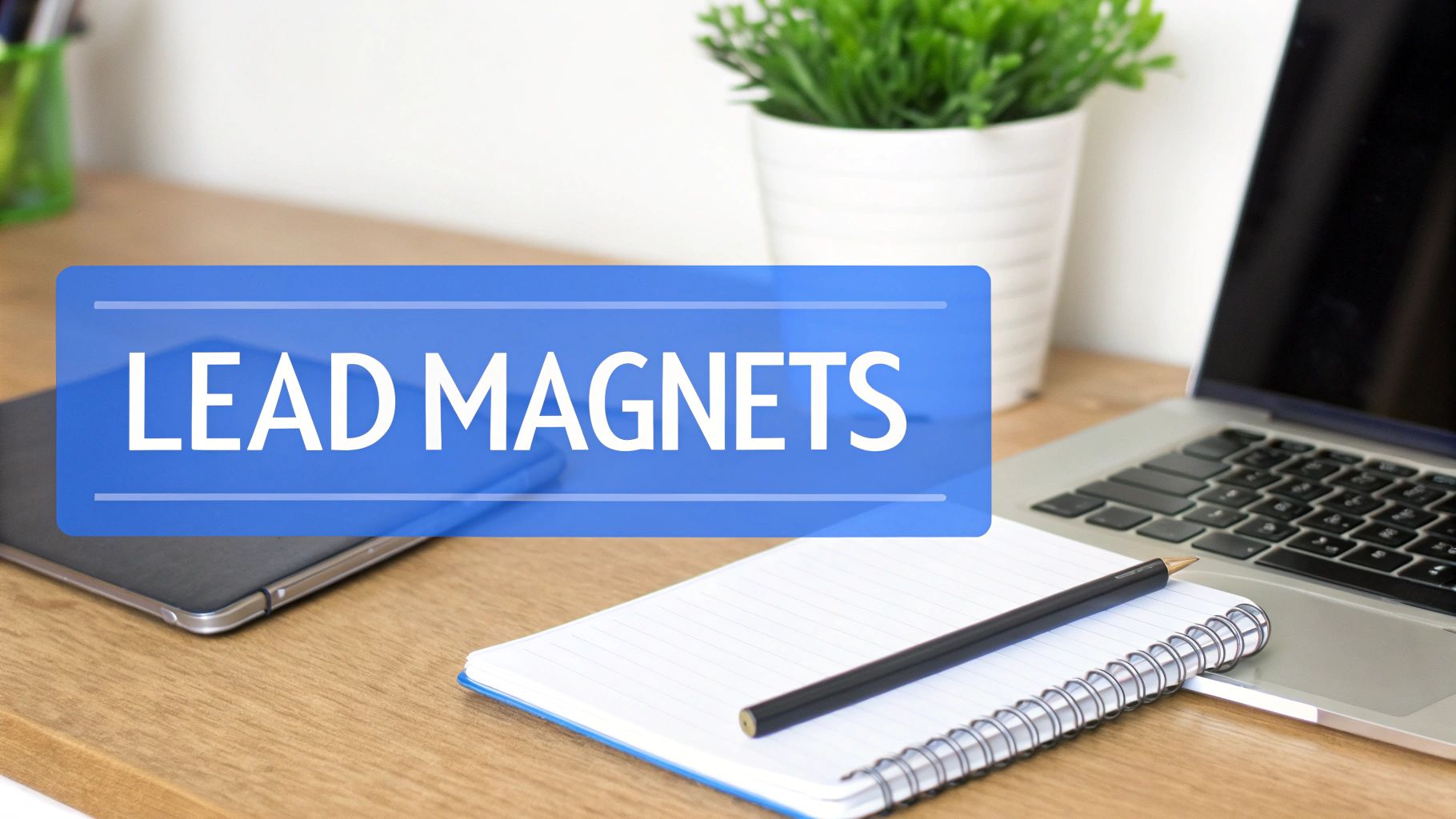
What Content Formats Generate the Most Leads?
Your audience isn't a single entity. Their needs and questions evolve as they move from first hearing about a problem to actively choosing a solution. The secret is to build a library of content that meets them exactly where they are.
You'll need more than just a blog to build a powerful lead-gen engine. Some of the most effective formats include:
- In-Depth Blog Posts: These are your workhorses. They pull in traffic from search engines, answer burning questions, and start positioning you as an authority.
- Ebooks and Whitepapers: When a blog post just scratches the surface, these long-form guides offer the deep dive your prospects are looking for. They're perfect for the Consideration stage.
- Webinars: Whether live or on-demand, webinars create a personal, interactive connection. They're brilliant for showcasing expertise and capturing high-intent leads.
- Case Studies: Nothing builds trust faster than proof. Case studies show prospects in the Decision stage that you deliver real results for businesses just like theirs.
The numbers don't lie. Content marketing is three times more efficient at generating leads than outbound tactics. And get this: businesses that publish at least 16 blogs per month generate 4.5 times more leads than those that don't. The link between consistent, quality content and a full pipeline is undeniable.
How to Match Content Formats to the Buyer's Journey
To make this practical, you need to map your content types to where your buyer is in their journey. A person just realizing they have a problem (Awareness) needs very different information than someone ready to buy (Decision).
Here's a quick table to help you visualize how this works:
Using a framework like this ensures you have the right bait for the right fish, guiding prospects smoothly from one stage to the next.
Maintaining Quality as You Scale
As your inbound machine starts humming, the pressure to produce more, faster, is a classic trap. Don't sacrifice quality for quantity. A single, deeply helpful piece of content will always outperform ten mediocre articles.
Here’s how to keep the bar high as you grow:
- Focus on Evergreen Topics: Build content around core industry challenges—the stuff that will still be relevant years from now. This ensures a long-term return on your effort.
- Repurpose Like a Pro: Turn a popular blog post into an infographic, expand a webinar into an ebook, or chop up a case study into social media posts. This maximizes the value of everything you create.
- Personalize the Experience: Use data to serve up content that feels like it was made just for each lead. Understanding how to use dynamic content for SEO can give you a massive edge here.
Getting Your Content Discovered
So you’ve created a phenomenal piece of content. That’s a huge win, but it's only half the battle. If your target audience never sees it, all that hard work might as well not exist. This is where your inbound marketing lead generation strategy really kicks into gear.
This isn’t about crossing your fingers and hoping for the best. It's a smart, two-pronged approach that combines the long-term staying power of search engine optimization (SEO) with the immediate buzz of content promotion.
Think of SEO as building a lighthouse. It's a permanent fixture that guides ships (your ideal customers) to your shore, day in and day out. Promotion, on the other hand, is like sending out speedboats to meet those ships where they are, right now.
You need both. Without SEO, your content’s visibility dies the second you stop promoting it. Without promotion, you're waiting for Google to notice you, missing out on immediate traffic and potential leads.
Demystifying SEO for Inbound Marketing
At its core, SEO is about making your website more attractive to search engines like Google. When someone types a question into the search bar, you want your content to pop up as a top answer. It all starts with understanding the exact words and phrases your buyer personas are using.
Keyword research isn't a simple game of finding popular terms. It’s about matching searcher intent to their stage in the buyer's journey.
- Awareness Stage Keywords: These are usually questions about a problem. For example, "why is my ad spend so high?" or "signs of an inefficient sales process."
- Consideration Stage Keywords: Here, people are comparing solutions. Think "inbound marketing vs. outbound" or "best lead generation software."
- Decision Stage Keywords: These are more specific, often including brand names. Examples could be "[Your Competitor] alternative" or "[Your Brand] pricing."
Once you know your keywords, weave them naturally into your page titles, headings, and body copy. You're sending clear signals to Google about what your content is about, making it easier for the search engine to connect you with the right person.
The real power of SEO is that it allows you to attract leads who are already interested in what you offer. Your content becomes the solution they were actively looking for.
How to Amplify Your Reach with Smart Promotion
While SEO slowly builds long-term momentum, content promotion gives you that initial boost. Never just hit "publish" and hope for the best. Every piece of content you create deserves a solid promotion plan to squeeze out every drop of value.
A repeatable promotion checklist ensures your hard work doesn't just collect digital dust. It pushes your message out to a wider, more relevant audience, which is exactly what you need to accelerate lead generation.
Here’s a simple but effective checklist you can adapt:
- Email Your Subscribers: Your email list is your built-in audience. They already know and trust you. Send them a dedicated email announcing your new content.
- Share Across Social Media: Post your content on all your key platforms, whether that's LinkedIn, X (formerly Twitter), or Facebook. Tweak the message for each platform and use eye-catching visuals. Don't just post once; schedule multiple shares to maximize reach.
- Engage in Online Communities: Find where your ideal customers hang out, like specific groups on LinkedIn or relevant subreddits on Reddit. Share your content when it genuinely helps answer a question—no spamming!
- Reach Out to Influencers: Think about the key voices in your industry. A simple, personalized email about a new resource can lead to a powerful share or a valuable backlink.
By combining a rock-solid SEO foundation with consistent promotion, you create a powerful system. SEO delivers a steady, organic stream of visitors, while promotion generates immediate traffic and social proof. This dual approach ensures your inbound marketing engine is always humming.
How to Convert Website Traffic Into Leads
Getting traffic to your site is a great start, but it's only half the battle. The real magic happens when your inbound marketing lead generation strategy can turn those anonymous visitors into actual leads. This is the moment a casual browser becomes a tangible opportunity.
It doesn’t happen by accident. You need a finely tuned system of calls-to-action (CTAs), landing pages, and forms working in perfect harmony. Each piece has a specific job: to guide your visitor, earn their trust, and make it ridiculously easy for them to say "yes."
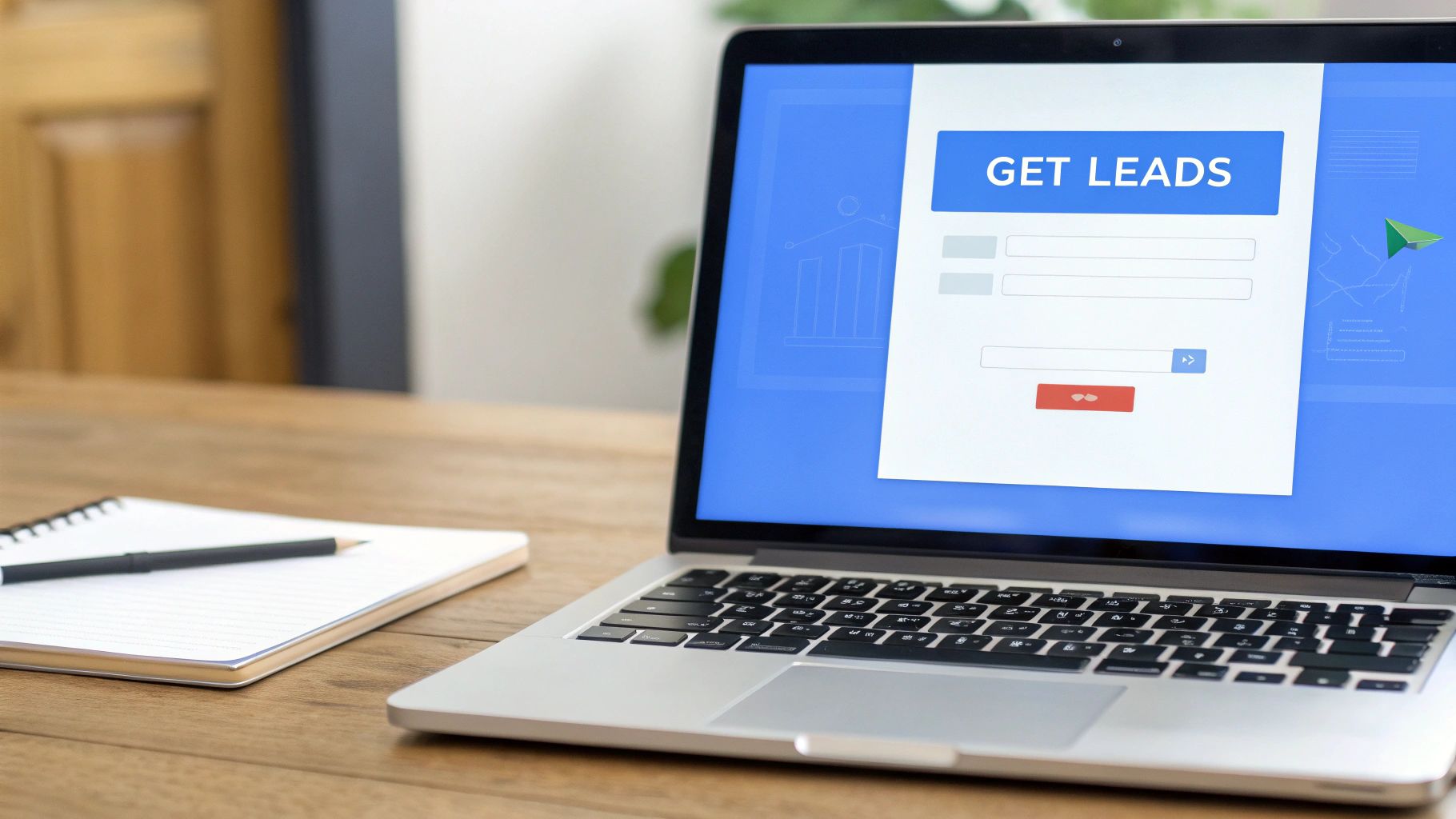
Crafting Calls to Action That Get Clicks
Think of a Call-to-Action (CTA) as the front door to your offer. It’s the button, link, or image that nudges a visitor to take the next step. A weak CTA is easily ignored, but a powerful one is almost irresistible. The secret? Make it clear, compelling, and action-oriented.
Ditch the generic stuff like "Click Here" or "Submit." Your CTA copy needs to promise specific value.
- Instead of "Download," try "Get My Free Marketing Guide."
- Instead of "Subscribe," try "Join 5,000+ Smart Marketers."
- Instead of "Learn More," try "See How It Works."
The design matters just as much. Your CTA button needs to pop. Use a contrasting color so it stands out, making it the most obvious thing to click. Research shows that just making your CTAs look like actual buttons can boost conversions by a whopping 45%.
Designing Landing Pages That Convert
Once someone clicks that CTA, they arrive at your landing page. This page has one mission: get the visitor to fill out your form. Anything that distracts from that goal is killing your conversion rate.
The best landing pages are ruthlessly focused. They remove all navigation, sidebars, and extra links, creating a direct path between the visitor's interest and your form. This clarity is key to maximizing lead capture.
A high-converting landing page needs a few key ingredients:
- A Clear Headline: It must match the promise of the CTA so the visitor instantly knows they're in the right place.
- Concise Copy: Use bullet points to quickly highlight the benefits. What will they learn? What problem will this solve?
- Compelling Visuals: Show an image of the ebook cover, a clip from the webinar, or a graphic that reinforces the value.
- Social Proof: A quick mention of how many people have already downloaded the offer or a short testimonial can work wonders.
Building Forms People Actually Complete
The final piece of this puzzle is the form. Let's be honest, this is where most people bail. A form that's too long or asks for info that feels too personal creates friction. The golden rule is simple: only ask for what you absolutely need right now.
For a top-of-funnel offer like an ebook, a name and an email address are usually plenty. You can always gather more details later as you build the relationship. Using a tool like LanderMagic can help you create optimized forms and landing pages that adapt to your audience, making the experience feel smooth and personal.
By nailing these three elements—the CTA, landing page, and form—you create a reliable machine that turns your hard-won website traffic into a steady stream of qualified leads.
How to Nurture Leads and Drive Sales
So, you’ve captured a new lead. That’s a huge win, but it’s definitely not the finish line. Think of it as the start of the conversation. Most people aren't ready to buy the moment they download your content. This is where your inbound marketing lead generation strategy shifts gears from attracting strangers to building real relationships.
The next critical step? Lead nurturing.
A new lead is like someone walking into your retail store for the first time. You wouldn't immediately shove your most expensive product in their face, right? You'd greet them, find out what they’re looking for, and offer helpful advice. Lead nurturing is the digital version of that process. It’s about building a relationship by delivering personalized, useful content that guides people toward a purchase decision—on their own time.
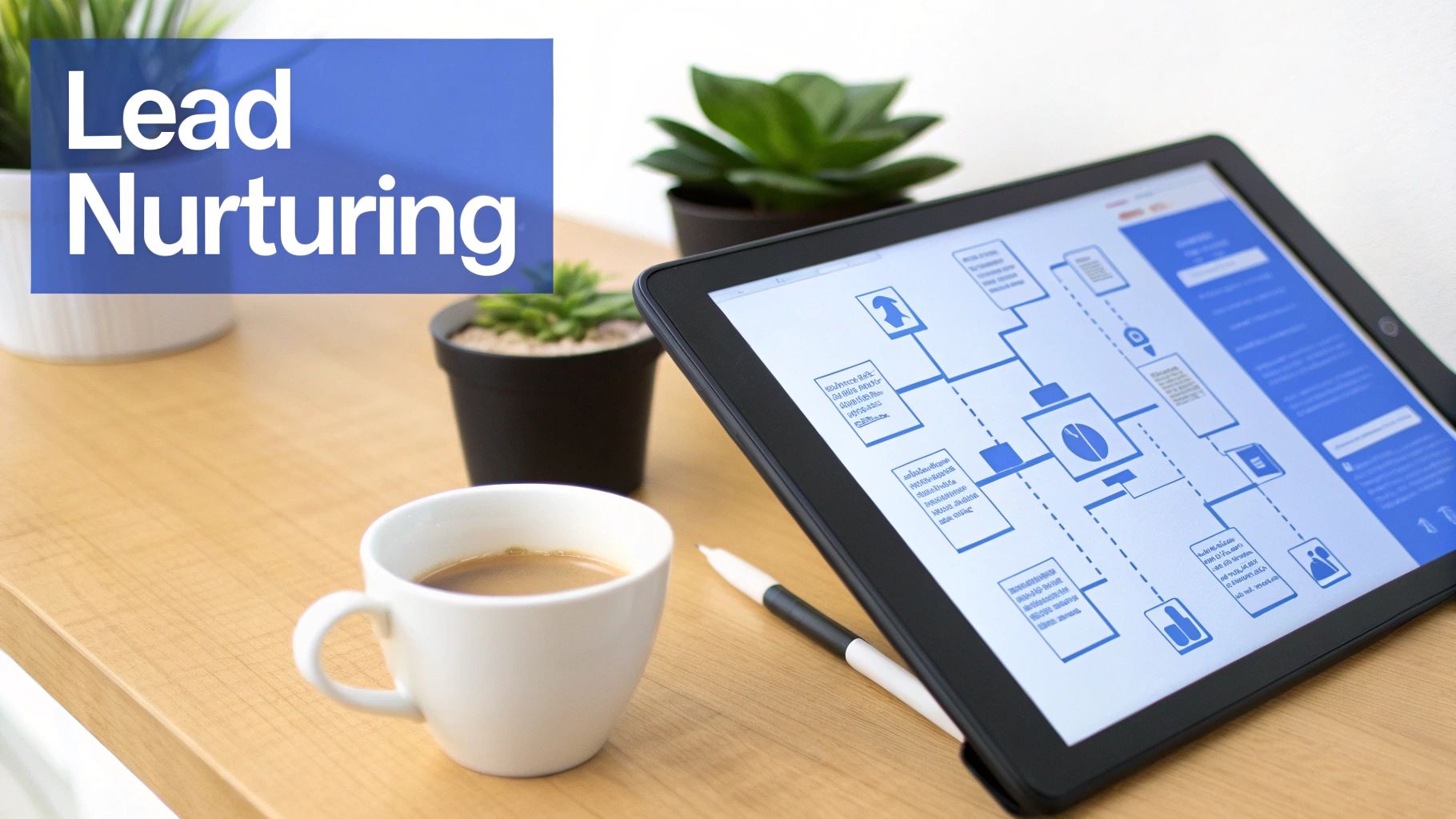
Using Marketing Automation to Build Relationships
Trying to manually send the perfect email to every lead at just the right moment is impossible. This is where marketing automation becomes your best friend. Platforms like HubSpot or Marketo let you set up automated workflows that send targeted content based on a lead’s behavior.
For instance, if someone downloads your guide on social media marketing, you can automatically drop them into a simple email sequence:
- Email 1 (Day 1): A quick thank you with a link to a related blog post, like "3 Common Social Media Mistakes to Avoid."
- Email 2 (Day 4): An invitation to a webinar about "Advanced Social Media Ad Strategies."
- Email 3 (Day 7): A case study showing how you helped a similar company double its social media engagement.
This approach keeps your brand top-of-mind, delivers consistent value, and gently nudges the prospect forward without ever feeling pushy.
To give you a clearer picture, here’s what a simple nurturing campaign might look like over a few weeks.
Example Lead Nurturing Campaign Timeline
This timeline shows how a mix of content and channels can methodically build trust and guide a lead from initial interest to sales-readiness.
How to Identify Your Hottest Prospects with Lead Scoring
Not all leads are created equal. Some are just window shopping, while others are seriously considering a purchase. Lead scoring is the system you use to tell them apart. It's a method of assigning points to leads based on who they are (demographics like job title or company size) and what they do (actions like visiting your pricing page or opening every email).
Once a lead’s score hits a certain threshold, they’re automatically flagged as a "sales-qualified lead" (SQL) and passed to your sales team. This step ensures your sales reps only spend their time on the most promising opportunities.
The payoff for a solid nurturing process is massive. According to lead generation statistics from SeoProfy, nurtured leads are 47% more likely to make a purchase and generate 20% more sales opportunities. The data makes it clear: consistent, valuable follow-up is the key to maximizing revenue.
How to Align Marketing and Sales for a Smooth Handoff
The final piece of this puzzle is creating a seamless handoff from marketing to sales. All too often, fantastic leads fall through the cracks here. To prevent that, both teams need to agree on a few key things:
- The definition of a qualified lead: What specific criteria must a lead meet before they’re sent to sales?
- The handoff process: How is the lead’s information transferred? What context does the sales rep need to have a successful conversation?
- A feedback loop: Sales must report back on the quality of the leads they receive so marketing can fine-tune its targeting and content.
When marketing and sales stop operating in silos and start working together, the entire system becomes a well-oiled machine. Marketing delivers higher-quality leads, and sales can close more deals because they’re talking to well-informed, engaged people.
Got Questions About Inbound Lead Generation?
Even with a solid inbound marketing strategy, a few questions always pop up. Let's tackle some of the most common ones to set realistic expectations for your journey.
What's the Real Difference Between an Inbound and Outbound Lead?
It all boils down to who starts the conversation.
An inbound lead is someone who comes to you. They found your blog post or downloaded your guide because they were already looking for answers. They're raising their hand for help.
An outbound lead is someone your team contacts first, totally unprompted. Think cold calls or direct email blasts where you're pushing your message onto them.
An inbound lead raises their hand; an outbound lead gets a tap on the shoulder. It’s a completely different dynamic from the very first interaction.
How Long Does It Really Take to See Inbound Results?
Let's be clear: inbound marketing is a long game, not a quick fix. While you might snag a few leads in the first couple of months, building a reliable engine for your business takes commitment.
Most businesses start to see a significant, consistent flow of leads and a real return on their investment within 6 to 12 months. This gives your SEO efforts time to gain traction and for your content library to build authority.
Patience is everything. The work you put in during the first year creates a snowball effect, delivering better and more qualified leads over time.
What Are the Must-Have Tools to Get Started?
You don't need a massive, expensive tech stack right away. But a few core tools are non-negotiable if you want to build an effective system.
- Analytics Platform: You have to know what's working. A tool like Google Analytics is essential for tracking website traffic, understanding user behavior, and measuring content performance.
- CRM (Customer Relationship Management): You need one central place to track all your leads. You can't manage this on a spreadsheet for long. Free options, like the HubSpot CRM, are a perfect place to start.
- Landing Page Builder: This is absolutely critical for turning visitors into leads. A dedicated builder makes it simple to create focused, high-converting pages without needing a developer.
Once you start growing, you can layer in email marketing and marketing automation platforms to nurture those leads more effectively.
Ready to turn more clicks into customers with perfectly optimized landing pages? LanderMagic uses AI to create dynamic, high-converting post-click experiences that match your ad campaigns, boosting conversions and maximizing your ROI. Discover how LanderMagic can transform your campaigns today!



